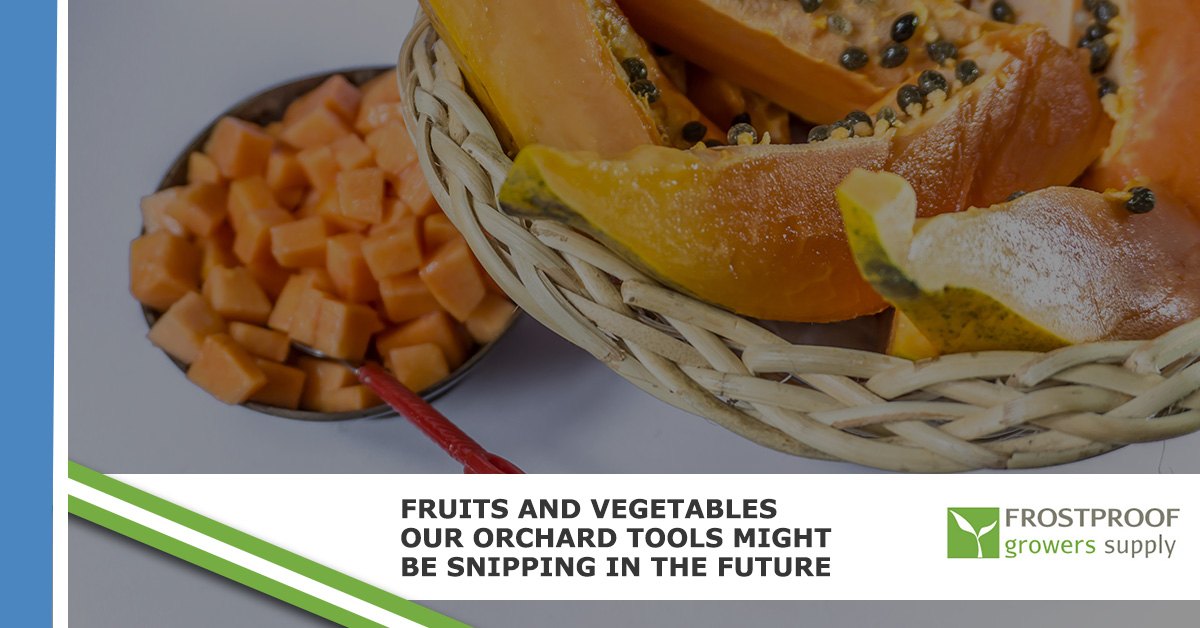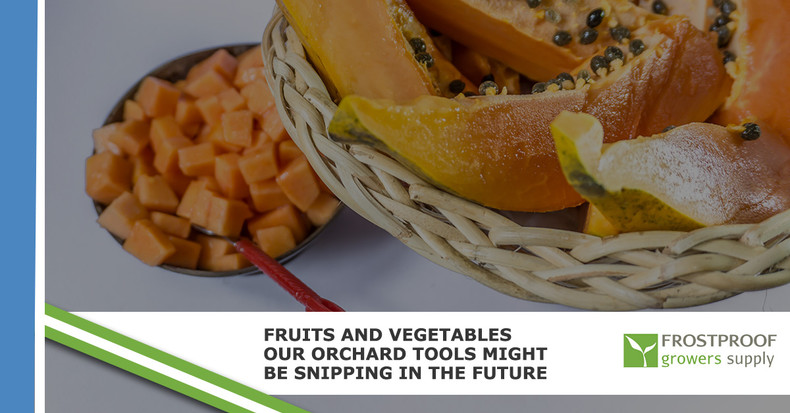
Head to any grocery store in a big city and you’re going to find more options than ever. We’re not just talking about in the cereal aisle or the new olive bar they installed next to the selection of cheeses from around the world. The fact is that there’s a greater variety of fruits and vegetables in the common grocery store than there has ever been. If you take specialty grocers into account, that number grows even greater.
We serve a variety of customers here at Frostproof Growers Supply. Some are here for orchard tools that will help them harvest the fruits of the future to feed a hungry planet. Others are looking for nursery supplies to grow the next generation of fruit trees, either to sell to those orchard growers or to provide the public with trees. Of course, some of our customers are the ones looking for garden hand tools to take care of their new plants that they bought from the nursery or garden center.
Today we’re going to take a look at some fruits and vegetables that are making a comeback or are becoming more popular in our country. They’re not all tree-based, but we bet you’ll be seeing more of them in the future at your local grocery.
Pawpaw
Let’s start with the fruit that inspired this article: the pawpaw. The pawpaw (sometimes spelled paw paw, or paw-paw, or PawPaw) is native to eastern North America and was actually the largest fruit native to the continent (when comparing pre-agriculture specimens). Pawpaws are most often compared to the Cavendish banana in both texture and flavor. (Cavendish are the most common banana at grocery, the one you’ve been eating all your life.) They can be eaten fresh, baked in a pie, froze, preserved in jams and jellies, or dehydrated. The pawpaw has been eaten by Americans for centuries, with founding fathers like George Washington and Thomas Jefferson being big fans. Lewis and Clark depended on them during their expeditions.
Why hasn’t the pawpaw really caught on as a recognizable fruit? The fact that they don’t ship or travel very well before spoiling is one reason that they haven’t become as popular as other fruits such as apples or pears. In fact, most Americans are still unfamiliar with it beyond the offhanded reference in the song “The Bare Necessities” in Disney’s The Jungle Book. (Interestingly, the pawpaw doesn’t grow outside North America, so we’re not sure where Baloo was getting them from!)
The popularity of the pawpaw is increasing because of the interest some people have in eating local, as well as the interest in backyard gardening and fruit tree growing. If you run across any pawpaws, give them a try!
Heirloom Tomatoes
While they don’t grow on trees, tomatoes are certainly one of the world’s most popular fruits, Unfortunately, tomatoes in most grocery stores are picked too early and are generally flavorless. Even as they breed tomatoes to look redder, the lack of flavor remains.
Heirloom tomatoes are tomatoes that come from old varieties of tomatoes, those that were grown before ship-ability took precedence over flavor. Heirloom tomatoes are often grown in backyards or found at farmers markets, and they really show you the great variety of flavor that tomatoes can deliver. Nutrition is also much higher, as they can be left on the vine to become ripe.
Aronia Berries
Aronia berries, sometimes called chokeberries, are native to North America. They grow on shrubs and are about the size of a blueberry. Aronia berries certainly aren’t sweet, and they’re most likely to make one’s mouth pucker.
Why are they becoming more popular? Many people enjoy them as a health food, particularly those who work out a lot. The anthocyanins in aronia berries are more concentrated than in nearly any other fruit. Many believe these polyphenols reduce free radicals and help people recover from workouts faster so that they can feel better and work out again in short order.
Fennel
Fennel is really pretty amazing. You can eat the leaves, you can eat the stems, and you can eat the bulb. Fennel stems look and crunch like celery, but unlike celery are loaded with many more vitamins and minerals. It has a very light black licorice flavor, so light that many people who don’t tend to like black licorice don’t seem to mind.
Fennel is usually grown in the Mediterranean, but can be grown elsewhere in the world. We see fennel as being a big deal in the future for one reason: it’s incredibly healthy. Once again, let’s compare it to celery, which is only high in Vitamin K. Fennel, on the other hand, is high in thiamin, riboflavin, niacin, Vitamin B6, Vitamin C, calcium, iron, magnesium, manganese, phosphorus, potassium, and zinc. It’s an amazing fiber-filled snack, and we hope it takes off so that the price will drop way down.
Brussel Sprouts
For years, Brussel sprouts were a joke. They were perhaps the most maligned vegetable out there, and with good reason: they were often horribly prepared! Most of them were boiled into oblivion and then covered in butter, which made them barely palatable.
Then came the grilled Brussel sprout. In the last year, grilled Brussel sprouts have exploded as a tasty, healthy way to eat something that, as it turns out, is quite good! Smashburger now offers it as a side if you don’t want french fries, and grocery stores like Sprouts are starting to carry them in their deli case. We anticipate Brussel sprout production exploding as more people get health conscious and cooks start to explore more tasty possibilities.
Kalettes
Okay, you’ve heard of kale; it’s the high-vitamin, high-mineral, high-fiber wondergreen of the last decade. And you’ve heard of Brussel sprouts, because we just talked about them in the last paragraph.
Now imagine them combined! That’s the Kalette, the brand name for a hybrid of Brussel sprouts and kale. These two plants have been bred using traditional breeding techniques in order to create a food that’s incredibly healthy and much easier to eat than a Brussel sprout, especially when eaten raw. Think of them as tightly-packed kale or loosely-packed Brussel sprouts. They also have a streak of red, which helps them brighten up traditional salads. Considering the nutritional punch of these cool little plants, we really expect them to take off soon.
Grab Your Growers Supply Tools Today!
We know that most of the people looking for orchard supplies aren’t here to grab fruit clippers for their pawpaw trees; more often it’s the citrus clippers they need. But fruit and vegetable popularity changes over the decades, so no one really knows what types of orchard, gardening, and nursery supplies will be needed. One thing is for sure, Frostproof Growers Supply will be here to provide all of the tools that growers both large and small need!

